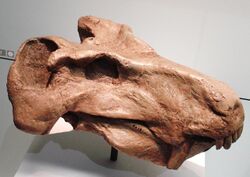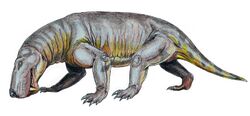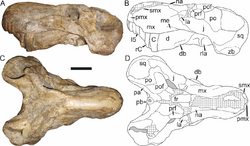Biology:Rubidgea
| Rubidgea | |
|---|---|

| |
| Skull of Rubidgea atrox | |
| Scientific classification | |
| Domain: | Eukaryota |
| Kingdom: | Animalia |
| Phylum: | Chordata |
| Clade: | Synapsida |
| Clade: | Therapsida |
| Clade: | †Gorgonopsia |
| Family: | †Gorgonopsidae |
| Tribe: | †Rubidgeini |
| Genus: | †Rubidgea |
| Type species | |
| †Rubidgea atrox Broom, 1938
| |
| Species | |
| |
| Synonyms | |
|
Genus-level
Species-level
| |
Rubidgea is a genus of gorgonopsid from the upper Permian of South Africa and Tanzania, containing the species Rubidgea atrox.[1][2] The generic name Rubidgea is sometimes believed to be derived from the surname of renowned Karoo paleontologist, Professor Bruce Rubidge, who has contributed to much of the research conducted on therapsids of the Karoo Basin. However, this generic name was actually erected in honor of Rubidge's paternal grandfather, Sydney Rubidge, who was a renowned fossil hunter. Its species name atrox is derived from Latin, meaning “fierce, savage, terrible”. Rubidgea is part of the gorgonopsian subfamily Rubidgeinae, a derived group of large-bodied gorgonopsians restricted to the Late Permian (Lopingian). The subfamily Rubidgeinae first appeared in the Tropidostoma Assemblage Zone. They reached their highest diversity in the Cistecephalus and Daptocephalus assemblage zones of the Beaufort Group in South Africa .[3][4][5]
History of discovery
The first Rubidgea fossil was discovered by C. J. M. "Croonie" Kitching, the father of renowned paleontologist James Kitching, on the farm Doornberg outside the small town Nieu-Bethesda sometime in the 1930s. In a paper published in 1938, Robert Broom named the fossil Rubidgea kitchingi.[6] Broom noted the large size of the new gorgonopsid fossil, stating that it was a new species.[7] Subsequent discoveries in the following decades confirmed Broom's suspicions that a new subfamily of gorgonopsians should be categorised, and the Rubidgeinae was erected.[8]
Description

Rubidgea was the largest African gorgonopsian[9] and one of the largest gorgonopsians known to have lived. The largest specimens had skulls that measure up to 46 cm (1.51 ft) in length. Rubidgea was a heavily-built, large-bodied apex predator, and sported a thick skull with long, sabre-like canines.[10][11] The Rubidgeinae group as a whole were some of the largest gorgonopsians known to have lived, only outsized by Inostrancevia, and are characterised by their robust skeletal features, particularly their skulls which are heavily-pachyostosed. The genus Rubidgea is composed of three species, R. atrox, R. platyrhina, and R. majora.[9]
Classification

The Rubidgeinae are a subfamily of derived gorgonopsids that have only been found in Africa. They are composed of six genera and 17 species. The Rubidgeinae are closely related to their sister group, the Inostranceviinae, which have only been found in Russia . Out of the gorgonopsian clade, the systematics of the Rubidgeinae is the best resolved due to their distinctive character traits. The systematics of other gorgonopsian subfamilies remain chaotic due to a high degree of cranial homomorphism between taxa, making it difficult to distinguish different taxa effectively.[12][13][14][15][16][17][18][19][20][21] The cladogram below (Kammerer and Rubidge 2022) displays the currently accepted systematic relationships of the Gorgonopsia.[22]
| Gorgonopsia |
| |||||||||||||||||||||||||||||||||||||||||||||||||||||||||||||||||||||||||||||||||||||||||||||||||||||||||||||||
Correlation
Numerous therapsid species, including rubidgenae gorgonopsids, are used as biostratigraphic markers in other African Basins, such as the Upper Madumabisa Mudstone Formation of Zambia, and the Chiweta Beds of Malawi.[23] Rubidgea fossils have been recovered from the Usili Formation of Tanzania, indicating biostratigraphic correlation with upper Permian-aged deposits in South Africa .[24] No rubidgeinae fossils have been found outside of African deposits to date, although the Inostranceviinae are considered to be their Russian counterparts.
References
- ↑ Rubidge, Bruce S.; Sidor, Christian A. (2001). "Evolutionary Patterns Among Permo-Triassic Therapsids". Annual Review of Ecology and Systematics 32 (1): 449–480. doi:10.1146/annurev.ecolsys.32.081501.114113.
- ↑ CHINSAMY-TURAN, ANUSUYA (2011-11-18) (in en). Forerunners of Mammals: Radiation • Histology • Biology. Indiana University Press. ISBN 9780253005335. https://books.google.com/books?id=cp26-CA2CDUC&q=++Chinsamy-Turan,+A.+ed.,+2011.+Forerunners+of+Mammals:+Radiation%E2%80%A2+Histology%E2%80%A2+Biology.+Indiana+University+Press.&pg=PR7.
- ↑ Lingham-Soliar, Theagarten (2014). "Mammal-Like Reptiles". in Lingham-Soliar, Theagarten (in en). The Vertebrate Integument Volume 1. Springer Berlin Heidelberg. pp. 193–219. doi:10.1007/978-3-642-53748-6_8. ISBN 9783642537486.
- ↑ Day Michael O.; Ramezani Jahandar; Bowring Samuel A.; Sadler Peter M.; Erwin Douglas H.; Abdala Fernando; Rubidge Bruce S. (2015-07-22). "When and how did the terrestrial mid-Permian mass extinction occur? Evidence from the tetrapod record of the Karoo Basin, South Africa". Proceedings of the Royal Society B: Biological Sciences 282 (1811): 20150834. doi:10.1098/rspb.2015.0834. PMID 26156768.
- ↑ Viglietti, P.A.; Smith, R.M.; Angielczyk, K.D.; Kammerer, C.F.; Fröbisch, J.; Rubidge, B.S. (January 2016). "The Daptocephalus Assemblage Zone (Lopingian), South Africa: a proposed biostratigraphy based on a new compilation of stratigraphic ranges". Journal of African Earth Sciences 113: 153–164. doi:10.1016/j.jafrearsci.2015.10.011. Bibcode: 2016JAfES.113..153V.
- ↑ Broom, Robert. "20. On a New Family of Carnivorous Therapsids from the Karroo Beds of South Africa." In Proceedings of the Zoological Society of London, vol. 108, no. 3, pp. 527-533. Oxford, UK: Blackwell Publishing Ltd, 1938.
- ↑ Kitching, J. W. (1953) (in en). Studies on new specimens of the Gorgonopsia. http://wiredspace.wits.ac.za/handle/10539/14667.
- ↑ Cruickshank, A. R. I. (1973). "THE MODE OF LIFE OF GORGONOPSIANS" (in en). Palaeontologia Africana. ISSN 0078-8554. http://wiredspace.wits.ac.za/handle/10539/16039.
- ↑ 9.0 9.1 Kammerer, Christian F. (2016-01-26). "Systematics of the Rubidgeinae (Therapsida: Gorgonopsia)" (in en). PeerJ 4: e1608. doi:10.7717/peerj.1608. ISSN 2167-8359. PMID 26823998.
- ↑ Jenkins, Ian; Valkenburgh, Blaire Van (2002-10-01). "Evolutionary Patterns in the History of Permo-Triassic and Cenozoic Synapsid Predators" (in en). The Paleontological Society Papers 8: 267–288. doi:10.1017/S1089332600001121. ISSN 1089-3326.
- ↑ Kermack, Doris M.; Kermack, Kenneth A. (1984), Kermack, Doris M.; Kermack, Kenneth A., eds., "Dentitions, Tooth-Replacement and Jaw Articulation" (in en), The Evolution of Mammalian Characters (Springer US): pp. 66–88, doi:10.1007/978-1-4684-7817-4_5, ISBN 9781468478174
- ↑ Kemp T. S.; Parrington Francis Rex (1969-09-04). "On the functional morphology of the gorgonopsid skull". Philosophical Transactions of the Royal Society B: Biological Sciences 256 (801): 1–83. doi:10.1098/rstb.1969.0036. Bibcode: 1969RSPTB.256....1K.
- ↑ Sigogneau, D. (1968). "On the classification of the Gorgonopsia" (in en). Palaeontologia Africana. ISSN 0078-8554. http://wiredspace.wits.ac.za/handle/10539/16116.
- ↑ Sigogneau-Russell, D., 1989. Theriodontia 1: Phthinosuchia, Eotitanosuchia, Gorgonopsia.
- ↑ Martins, Rui M. S.; Fröbisch, Jörg; Polcyn, Michael J.; Fernandez, Vincent; Araujo, Ricardo M. (2017-02-21). "Aspects of gorgonopsian paleobiology and evolution: insights from the basicranium, occiput, osseous labyrinth, vasculature, and neuroanatomy" (in en). PeerJ 5: e3119. doi:10.7717/peerj.3119. PMID 28413721.
- ↑ Norton, Luke Allan (2013-02-01). Relative growth and morphological variation in the skull of Aelurognathus (therapsida: gorgonopsia) (Thesis thesis).
- ↑ Gebauer, Eva V. I. (2014), "Re-assessment of the Taxonomic Position of the Specimen GPIT/RE/7113 (Sauroctonus parringtoni comb. Nov., Gorgonopsia)", in Kammerer, Christian F.; Angielczyk, Kenneth D.; Fröbisch, Jörg (in en), Early Evolutionary History of the Synapsida, Vertebrate Paleobiology and Paleoanthropology, Springer Netherlands, pp. 185–207, doi:10.1007/978-94-007-6841-3_12, ISBN 9789400768413
- ↑ Kammerer, Christian F. (2014), "A Redescription of Eriphostoma microdon Broom, 1911 (Therapsida, Gorgonopsia) from the Tapinocephalus Assemblage Zone of South Africa and a Review of Middle Permian Gorgonopsians", in Kammerer, Christian F.; Angielczyk, Kenneth D.; Fröbisch, Jörg (in en), Early Evolutionary History of the Synapsida, Vertebrate Paleobiology and Paleoanthropology, Springer Netherlands, pp. 171–184, doi:10.1007/978-94-007-6841-3_11, ISBN 9789400768413
- ↑ Kammerer, Christian F. (2015). "Cranial osteology of Arctognathus curvimola, a short-snouted gorgonopsian from the Late Permian of South Africa" (in en). Papers in Palaeontology 1 (1): 41–58. doi:10.1002/spp2.1002. ISSN 2056-2802.
- ↑ Kammerer, Christian F.; Smith, Roger M. H.; Day, Michael O.; Rubidge, Bruce S. (2015). "New information on the morphology and stratigraphic range of the mid-Permian gorgonopsian Eriphostoma microdon Broom, 1911" (in en). Papers in Palaeontology 1 (2): 201–221. doi:10.1002/spp2.1012. ISSN 2056-2802.
- ↑ Fröbisch, Jörg; Fernandez, Vincent; Kardjilov, Nikolay; Kammerer, Christian F.; Bendel, Eva-Maria (2018-11-28). "Cranial anatomy of the gorgonopsian Cynariops robustus based on CT-reconstruction" (in en). PLOS ONE 13 (11): e0207367. doi:10.1371/journal.pone.0207367. ISSN 1932-6203. PMID 30485338. Bibcode: 2018PLoSO..1307367B.
- ↑ Kammerer, C. F.; Rubidge, B. S. (2022). "The earliest gorgonopsians from the Karoo Basin of South Africa". Journal of African Earth Sciences 194: 104631. doi:10.1016/j.jafrearsci.2022.104631. Bibcode: 2022JAfES.19404631K.
- ↑ Maisch, M.W., 2002. Observations on Karoo and Gondwana vertebrates. Part 3: Notes on the gorgonopsians from the Upper Permian of Tanzania. Neues Jahrbuch fur Geologie und Palaontologie-Monatshefte, (4), pp.237-251.
- ↑ Parrington, F. R. "A new genus of gorgonopsid from East Africa." Annals of the South African Museum 64 (1974): 47-52.
Wikidata ☰ Q1977910 entry
 |

